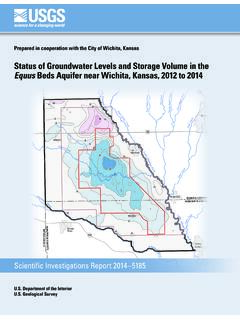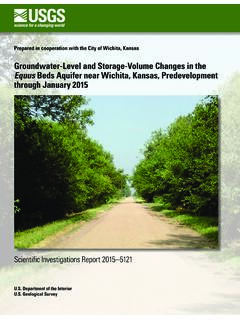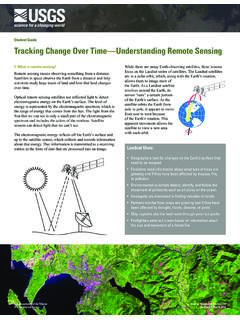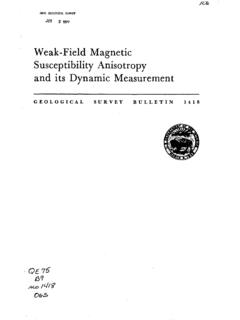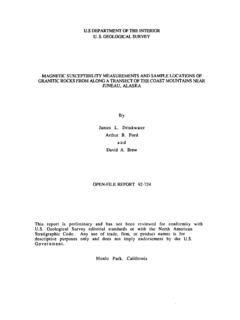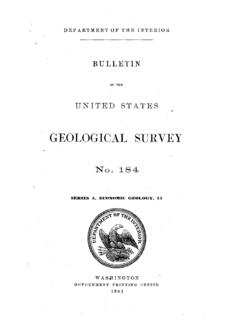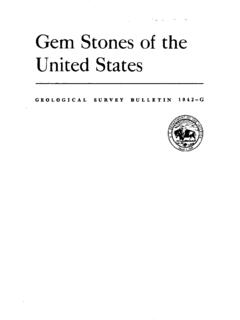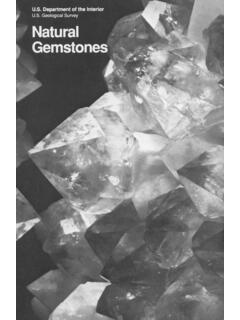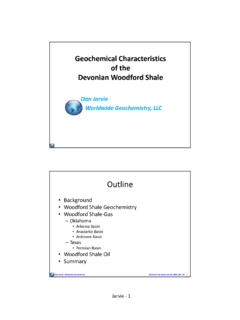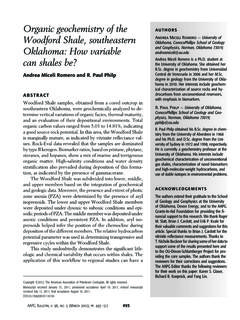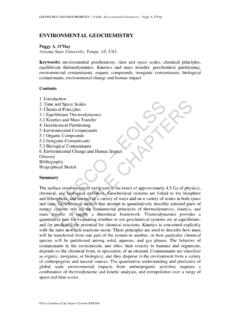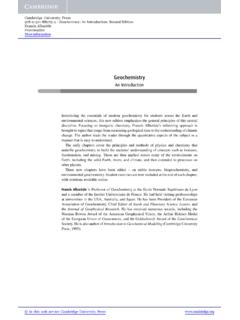Transcription of C56 REGIONAL AQUIFER-SYSTEM ANALYSIS—MIDWESTERN …
1 REGIONAL AQUIFER-SYSTEM analysis midwestern BASINS AND ARCHESC56consistent with the hypothesis that REGIONAL recharge to thispart of the aquifer system could be limited by the inability ofthe aquifer system to carry ground water away from the area is largely coincident with the area of weak regionaldischarge (fig. 28).Simulated discharge vectors indicate high magnitudes ofhorizontal REGIONAL flow in the carbonate-rock aquifer in theareas around the REGIONAL potentiometric highs (fig. 31B).High magnitudes of horizontal REGIONAL flow are also associ-ated with the downstream end of the Wabash and White Riv-ers, the margin of the Illinois (structural) Basin, the OhioRiver, an area west of the Scioto River, and the area east ofthe Sandusky River.
2 Discharge vectors along part of the LakeErie shore indicate that the magnitude of horizontal regionalflow in the carbonate-rock aquifer in this area is fairly flow may be predominantly vertical in this areabecause it is an area of REGIONAL ground-water discharge. Sim-ulated discharge vectors were computed for the upper weath-ered zone water-bearing unit, but the relative magnitudes offlow in this poorly permeable unit are so small that the vec-tors do not show up at the scale of figure should be noted that the discharge vectors show onlyrelative magnitudes of horizontal REGIONAL ground-water flowand do not indicate flow velocities.
3 Additional information onthe effective porosity of the aquifers would be necessary tocompute flow velocities. Appropriate effective-porosity datafor fractured carbonate rock are difficult to obtain and werenot available for this investigation. Ground-water ages pre-sented in the following section, however, provide insight intoground-water residence calibrated final model was not used to simulatepotential effects of future pumpage on REGIONAL ground-waterflow in the aquifer system . Data on future pumpage needs atthe REGIONAL scale are not available, and any simulations offuture pumpage at this time would be contrived.
4 It is notewor-thy, however, that only a small percentage of current pump-age is associated with the REGIONAL flow systems explicitlysimulated with this model. Therefore, more water associatedwith such REGIONAL flow systems almost certainly could beused. The quality of the ground water associated with someparts of the aquifer system , however, may limit its data were collected from the MidwesternBasins and Arches aquifer system to investigate the relationsamong ground-water chemistry, aquifer mineralogy, andpresent and past patterns of REGIONAL flow.
5 The data include asynthesis of basic data from more than 1,300 ground-wateranalyses of water samples from the aquifer system , as well asdetailed chemical and isotopic analyses of ground water andaquifer material along general directions of REGIONAL flow. Theanalyses represent two hydrologic units (table 1) within theMidwestern Basins and Arches aquifer system aquiferswithin glacial deposits and the carbonate-rock aquifer andwere obtained from records in the Geological Survey sNational Water Information system (NWIS) data base; filesof the Indiana Department of Natural Resources, the OhioDepartment of Natural Resources, and the Ohio Environmen-tal Protection Agency; various published reports; and samplescollected as part of this investigation.
6 The data were compiledand analyzed to investigate the ground-water chemistry of theaquifer system on a REGIONAL scale. Ground-water chemistryof subregional areas of the midwestern Basins and Archesaquifer system is described in the following reports: in Ohio,by Ohio Department of Natural Resources, Division of Water(1970), Norris and Fidler (1973), Norris (1974), Deering andothers (1983), Breen and Dumouchelle (1991); and in Indi-ana, by Geosciences Research Associates, Inc. and PurdueUniversity, Water Resources Research Center (1980) andIndiana Department of Natural Resources (1988, 1990).
7 Analyses of brines from rocks of Silurian and Devonian ageare found in Stout and others (1932), Lamborn (1952),Walker (1959), Stith (1979), Keller (1983) and Wilson andLong (1993a, b).Data compiled from the literature and the available databases were selected on the basis of the following criteria: (1)major-ion concentrations (Ca, Mg, Na, Cl, SO4, and HCO3)were determined, (2) the analyses balanced electrochemicallywithin 10 percent and, (3) lithologies of the water-producingunits were determined. In cases where multiple analyses wereavailable for a well, the most recent analysis that met theabove criteria was selected.
8 The dissolved-solids data formost of the analyses that were used in this report were calcu-lated by summing the concentrations of all major constituentsaccording to the method described in Fishman and Friedman(1989). Dissolved-solids concentrations for waters in the Illi-nois and Michigan Basins were estimated from borehole geo-physical data where available laboratory determinations weresparse ( Schnoebelen, Geological Survey, writtencommun., 1993).New data that were collected during this investigationinclude detailed chemical and isotopic analyses of groundwater from the aquifer system along general directions ofregional ground-water flow, as determined from the map ofthe potentiometric surface of the carbonate-rock aquifer ( ), and isotopic analyses of aquifer material collected fromcores of glacial deposits and carbonate rock.
9 The locations ofthe ground-water and aquifer -material samples are shown infigure 32. At each sampling location along four transectsacross the aquifer system , ground-water samples were col-lected from the carbonate-rock aquifer , and, where possible,from a glacial aquifer . Sampling was restricted to existingdomestic wells or test wells; wells with short open intervalsin the deep parts of the aquifer were generally not each sampling location, an attempt was made to samplethe deepest available well in the carbonate-rock aquifer inGEOCHEMISTRYC5784 86 42 40 38 Base from Geological Survey digital data,1.
10 2,000,000, 19720200204060 KILOMETERS4060 ClairChicagoIndianapolisDetroitColumbusC incinnatiToledoDaytonEvansvilleLouisvill eFortWayneSouthBendFrankfortLexingtonHun tingtonILLINOISMICHIGANINDIANAOHIOWESTVI RGINIAKENTUCKYONTARIOUNITEDSTATESCANADA1 D2G2D2SG53D3S4G4D4SC35G5S5D6D6G6S7S7D7GG 3C4G49D9G9S20212255755018D17D17G16D16G16 S15S15D15GG214SC214D54613S13D13G12S12D11 S11D11G10S10D10GC1G119D'DC'CBB'A'A8G8 DEXPLANATIONB oundary of study areaLocation of geochemical sectionWell sampled for chemical analysis during this investigation Number refers to tables 6, 7, and 8 Glacial aquifers Carbonate-rock aquifer , shallow Carbonate-rock aquifer , deepCore sampled for isotopic analysis Number refers to table 9 Core samples collected during this investigation Mineral samples collected by Botomon and Fauer (1976)D'D2G3D11SG2557 FIGURE 32.
